There's a scene in "Not Not Jazz," a film about the fusion jazz trio Medeski Martin & Wood, where the camera prowls around bassist Chris Wood as he slowly saws his upright bass on an upstate New York tennis court dotted with fallen leaves. There are a lot of scenes like that in "Not Not Jazz." I suspect that if you're as interested in the process of music as in the result, it'll be one of the elements you'll like most about the movie.
Directed by Jason Miller—and shot by camera operator Htat Lin Htut with such musicality that he deserves to be considered a fourth band member—"Not Not Jazz" is a short feature (74 minutes, not including credits). It perhaps feels a little too short for this viewer's taste, because it doesn't deliver on the stated premise that it's about watching a group improvise their way through a new album in the Hudson Valley's Allaire Studios (this turns out to be more of a pretext for a truncated and fragmented history of the band, scattered amid moments in which music is discussed, worked-through, or recorded).
The movie doesn't go in the other direction, either, and become the decadently committed wallow in ephemeral pleasures it could've gotten away with being. (The audience is going to be 95 percent people who like the band and/or jazz-adjacent music anyway.) There are references to internal conflicts that the band had over the years but it's not delved into. The best we get is a tossed-off remark from their manager Liz Penta (a producer on the movie) that they had to go into group therapy to work through problems and that there was a lot of crying.
Still, this is a lovely piece of work that compensates for its flaws and omissions by giving you things you rarely get in music documentaries. If you've been in a band or know anyone who's been in a band, you'll recognize the energy flowing between Wood, percussionist Billy Martin and keyboard player John Medeski. They're been together long enough (33 years) to have developed not just a rapport but their own language consisting of sound fragments, spoken and played.
It's not often that you're given as many opportunities as "Not Not Jazz" presents to see artists actually making art. The parts of the movie that concentrate on the process are far more eloquent than the standard-issue moments where we watch one of the band members walk through the woods while musing in voice-over. A piece might start out as an idea for a melody or rhythmic signature, get built-out in a session where the three guys noodle around, and be refined in conversations in the studio or some other room of the building (the kitchen is a hot spot) where two or all of the musicians discuss the work in progress. Sometimes one of them will say something like, "what if I go doot-doot-doot, doot-doot-doot-doot?" and another will answer or join in with their own cartoonish noise. They complete each other's sentences. Sometimes they don't even need to finish a sentence; one of them will go, "right, right," or something along those lines, and no further elaboration will be necessary.
Apparently, the road that led to this comfortable place wasn't smooth. The band reached prominence in the late 90s at a time when their recording label (then Blue Note, home of many jazz greats) was still financially supporting the efforts of instrumental-only ensembles like Medeski, Martin & Wood. Then record labels withdrew most of their support of that kind of music and the band had to find its own way through the marketplace.
They figured it out because they had a good sense of themselves early on, and doubled-down on that self-image rather than trying to do something that might have been perceived as commercial (whether any kind of jazz is really "commercial" is probably a subject for another movie, one I'd like to see). Penta—who booked them into CB's Gallery, the avant-garde boutique space within CBGB's in New York City—says the guys had a hunch that a wider audience of rock fans might vibe with their music if they could only put it in front of them. When Penta became their manager, she hired a booker who got them into a lot of punk rock-focused venues, where they thrived. "They are all very studied jazz or classical musicians," she says, "but they felt that music didn't necessarily belong in jazz clubs which felt exclusive or expensive. They wanted to take that music into rock clubs (because) people could access it."
This movie should probably be considered more promotional material than journalism, but that's not necessarily a bad thing because it's the most intellectually stimulating kind of promotion, concentrating on the illumination of the artistic process rather than cliches and hype. If you're not a musician, you'll come away from it feeling that a few of the aspects of music that were mysterious before have been somewhat illuminated. If you're a musician, you'll come away from it feeling seen, and heard.




















